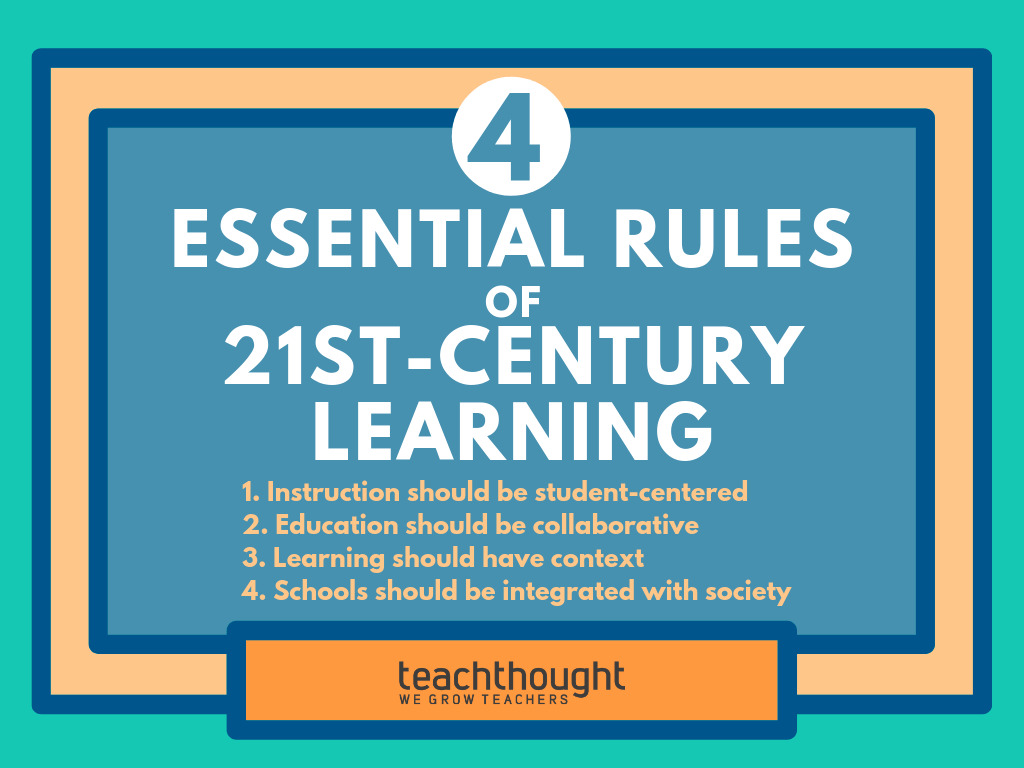
What Are The Essential Rules Of 21st Century Learning?
contributed by Jennifer Rita Nichols
The term “21st century” has become an integral part of educational thinking and planning for the future. Educators and administrators are actively searching for ways to prepare students for the future, and the educational system has been evolving faster than ever before.
Various studies have shown us that rote memorization is not an effective learning strategy and that teacher-centered classrooms (versus student-centered classrooms) may not be the most efficiently structured ones for student engagement.
However, despite learning about the skills that students will need to develop to become successful in the 21st century, as well as what beliefs about education may be worth hanging onto or throwing away, schools and teachers are left trying to figure out what their role needs to be in the education of their 21st century students.
Once upon a time, the role of the educator was to prepare students for the specific tasks they would be required to complete (be it a trade, craft, or profession). Communities were also much more homogenous, and so specific values and cultures needed to be transmitted and practiced to ensure the survival of those beliefs.
Nowadays, we don’t live in the same world. Society is a mix of many different beliefs and cultures. Globalization has opened up the world and allowed people to connect in new and exciting ways. We blend traditions and create unique belief systems that are not taught in any classroom, but are developed through our life experiences and passions. We transmit our values and cultures without the expectation of them being adopted by our audience – just accepted by them.
See also Why Social Interaction Is Essential To Learning Math
So then, what is the role of education in the 21st century?
As always, at its core, the role of education is to prepare students to become active, successful, and contributing members of society. The essence of education’s role has not changed.
However, there has been an important change that must be considered.
Society has changed. We cannot adequately prepare students for the society that exists today or will exist tomorrow, if we continue to prepare them for the society that existed yesterday. In order to prepare students to play their role in the 21st-century society we are a part of, a few things need to be considered when deciding how education will look in our schools and classrooms.

1. Instruction should be student-centered
The days of lecturing teachers has passed – though not entirely. While student-centered learning is strongly encouraged in the 21st century, this does not mean that the teacher can never give a lecture again. Instead, it means that the main source of knowledge in the classroom should not be the teacher. Education is no longer about listening to the teacher talk and absorbing the information.
In order to contribute to society, students will need to be able to acquire new information as problems arise. Then, they will need to connect the new information with the knowledge they already have and apply it to solving the problem at hand. They will not be able to call upon a teacher for answers, so will need to have ‘learned how to learn’ on their own.
In this classroom model, the teacher would act as a facilitator for the students. Instead of passively receiving information, the students would gather information on their own, under the guidance of their teacher. Different learning styles are encouraged, and students have an enhanced sense of motivation and responsibility. They engage in many different types of hands-on activities, as well as demonstrate learning in many different ways. Learning is about discovery, not the memorization of facts.
2. Education should be collaborative
Students must learn how to collaborate with others. Society today has people collaborating across the globe. How can students be expected to work with people from other cultures, with different values from their own, if they are not able to work with the people they see each day in their classroom?
Students should be encouraged to work together to discover information, piece it together, and construct meaning. Collaboration should also be dynamic. Students should learn how to recognize the different strengths and talents each person can bring to a project, and change roles depending on those attributes.
Schools should also be collaborating with other educational institutions around the world to share information and learn about different practices or methods that have been developed. They should be willing to alter their instructional methods in light of new advancements.
3. Learning should have context
Student-centered does not mean that the teacher gives up all control of the classroom. While students are encouraged to learn in different ways, the teacher still provides guidance as to the skills that need to be acquired. The teacher can make a point of helping students to understand how the skills they are building can be applied in their lives. Students will be much more motivated to learn something that they can see the value in.
Since we are no longer preparing students for specific tasks and roles, we need to take a more general approach and teach them the skills that are useful in any situation. Lessons have little purpose if they do not have any impact in a student’s life outside of the school.
4. Schools should be integrated with society
In order to prepare students to become responsible citizens, we need to model what a responsible citizen is.
Schools will often work at accomplishing this by creating events for the school community, by encouraging students to join committees or take part in school projects, and by occasionally helping the community around them with activities such as food drives or neighborhood clean-ups.
With the powers of technology and the internet, students of today can do even more. Our community is no longer just the area of space located around the school, but reaches out and envelopes the world.
Education needs to help students take part in this global community and find ways of impacting more than just their neighborhood. This doesn’t mean that they do not need to learn the value of helping others around them and protecting their immediate environment, but that they should also be learning about how they can help and protect a world further away from them, but also closer all the time.
Image attribution flickr users kjgarret and flickeringbrad; 4 Essential Rules Of 21st Century Learning
